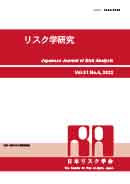Volume 31, Issue 4
Displaying 1-5 of 5 articles from this issue
- |<
- <
- 1
- >
- >|
Editorial
-
2022Volume 31Issue 4 Pages 279-280
Published: July 15, 2022
Released on J-STAGE: July 23, 2022
Download PDF (279K)
Special Feature COVID-19 Pandemic
Original Article
-
2022Volume 31Issue 4 Pages 281-293
Published: July 15, 2022
Released on J-STAGE: July 23, 2022
Download PDF (1821K)
Original Article
-
2022Volume 31Issue 4 Pages 295-303
Published: July 15, 2022
Released on J-STAGE: July 23, 2022
Download PDF (611K)
Review
-
2022Volume 31Issue 4 Pages 305-312
Published: July 15, 2022
Released on J-STAGE: July 23, 2022
Download PDF (2817K)
Books
-
2022Volume 31Issue 4 Pages 313-315
Published: July 15, 2022
Released on J-STAGE: July 23, 2022
Advance online publication: April 11, 2022Download PDF (328K)
- |<
- <
- 1
- >
- >|
